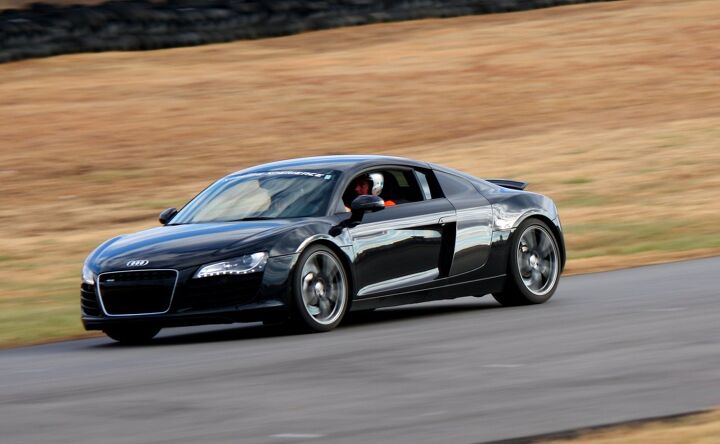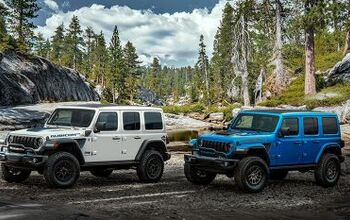Supercars To Go, Fifth Place: Audi R8 4.2 R-Tronic

Let’s start with this: Under no circumstances is a Lamborghini Gallardo “just an Audi R8”. The Gallardo was already old hat by the time the R8 arrived, having gone through three model years and one major revision. If anything, the R8 is a Gallardo, not the other way ’round.
Except it isn’t, which is both good and bad.
I’ve driven most variants of the Audi R8, starting from a 4.2 six-speed on the day that I met Murilee Martin for the first time all the way to the V10 Plus S-Tronic during last year’s R&T PCOTY. It would be an understatement to say that I’m fond of the model. There’s so much to admire: the aesthetically satisfying yet completely usable interior design, the superb amount of passengerr space compared to pretty much any other supercar, (including the Gallardo, which has a much lower roof) and the way it combines exotic-car looks with everyday practicality.
I was surprised at how often my single-serving students at the Xtreme Xperience mentioned Tony Stark and “Iron Man” as the reason they’d chosen to drive the R8. I never really thought of it as the “Iron Man” car. Apparently everybody else does. Not that the Audi doesn’t continue to look futuristic in its ninth year on the market. You can argue that it’s better-looking than the Gallardo. It’s certainly more noticeable on the street; through the miracle of fourteen thousand sales and a rather conservative shape, the baby Lamborghini no longer turns many heads.
Most people can comfortably wear a helmet in the R8. It’s not that difficult to park or maneuver at low speeds. The stereo and navigation are Audi-standard. Entry and exit is easier than in, say, a Viper (had to mention it for the sake of the B&B’s self-satisfaction!) and the seating position is also somewhat better than what you get in the Italians or the McLaren. If you had to cross the county in one of our Final Five, you’d take the Audi, no question about it. Even the climate control is luxury-car-spec, as I discovered when testing the original 4.2L cars during a Texas summer.
In isolation, the R8 feels rapid. There’s a brilliant noise from the 8250-rpm 4.2L V8, the R-tronic single-clutch automated manual doesn’t get confused on-track, and the acceleration seems more rapid than the 12.8-second quarter-mile time suggests. The front axle is always working, but it rarely works very hard. In wet conditions, it’s very confidence-inspiring and it can take full throttle in anything short of a full-on rainstorm.
Yet the modest tire size and significant stagger (235 in front, 285 in back) both make it easy to reach the R8 limits on-track and contribute to the Audi’s pace being noticeably lower than that of the other cars in this comparison. More so than any other car I drove that weekend, the R8 offers gentle, progressive, controllable understeer and very little sense of the heavy engine behind you. It’s the Cessna 172 of supercars: slow, stable, easy to get out of trouble. Dropping the tire stagger to 30mm or so, as I’ve done with my Porsche 993, would go a long way towards restoring the natural balance of the chassis, at the expense of predictability.
As the car with the oldest transmission technology in the group, the R8 has the worst automatic mode. For my students, I left the car in manual and shifted it for them. It was simply in the wrong gear at the wrong time otherwise. In manual mode, as noted above, it works fine, as long as your expectations are based on single-clutch hardware. This is not a Ferrari 458, which will handle repeated and random stabbing at brakes and throttle with instantaneous gearcharges perfectly chosen to maximize power or stability depending on one’s twist of the manettino. But it’s a bit better than the F430’s single-clutcher.
If you’re careful with the front tires, the R8 delivers a surprising amount of midcorner speed. It did, however, prove tricky in the turn known at Hallett as “The Bitch”. The Audi was simply more sensitive to low grip there than any of the other cars, likely because of the combination of narrow tires and significant rearward weight distribution of 44/56. (The Gallardo is usually quoted at 43/57 but I’d be surprised if the difference between the cars was a full percentage point.) Still, overall I’d say my students got more out of the R8 than they did out of anything but the GT-R.
So why fifth place? Well, it’s just this: The R8 looks like a supercar but it struggles to stay with V8 M3s and C6 Corvettes around a road course. The weight of 3,650 pounds or so is pretty considerable for the 415 horsepower on tap, particularly given the fact that torque peaks up at 4500rpm. It’s more show than go. If you choose the Audi R8 V10 Plus model, you’ll get a dual-clutch transmission and nearly a Gallardo’s worth of power — but the R8 V10 Plus doesn’t feel as light on its feet or as enthusiastic around a racetrack as the Gallardo LP-560. And in so doing, you’ll lose the V8 model’s characterful noises and real-world focus.
The best R8 to get is a six-speed manual 4.2V8 post-2012 model. If you get one of those, you’ll have all of Tony Stark’s style and daily usability to rival a Lexus ES350. You’ll just have to put on your turn signal when a real supercar appears. The next four cars in this test are on another level of performance entirely.

More by Jack Baruth
Latest Car Reviews
Read moreLatest Product Reviews
Read moreRecent Comments
- 28-Cars-Later Actually pretty appealing (apparently I'm doing this now). On a similar note, a friend of mine had a difficult situation with a tenant which led to eviction and apparently the tenant has abandoned a 2007 Jag S-Type with unknown miles in the garage so he called me for an opinion. Before checking I said $2-3 max, low and behold I'm just that good with the 3.0L clocking in at $2,3 on average (oddly the 4.2 V8 version only pulls $2,9ish) and S-Types after MY05 are supposedly decent.
- DO I have owned a 2012 LR4 since day one and it has been the best vehicle I have ever had the pleasure of having in the garage. I know how easy it is to hate on Land Rover but this LR4 is comfortable, has a ton of storage room and is so versatile. With 110k miles, mine is now relegated to ‘other’ car use but is still the go to for off road adventures and snow runs. Nice to see one featured here - I think they are so underrated.
- Tane94 I'd be curious to know whether 87 octane is no longer the most popular grade of gasoline by sales volume. My Costco often runs out of Premium grade and I suspect 93 octane might now be the most popular grade of gas. Paying 40-50 cents more per gallon 87 vs 93 octane because of turbo engines is the real story
- Redapple2 125 large? You re getting into 911 territory.
- Redapple2 Industry worst quality prevents any serious consideration. I ll take an Evil gm Vampire Denali first.


































Comments
Join the conversation
"I was surprised at how often my single-serving students at the Xtreme Xperience mentioned Tony Stark and “Iron Man” as the reason they’d chosen to drive the R8. I never really thought of it as the “Iron Man” car. Apparently everybody else does." I'm going to err on the side assuming you haven't seen the Iron Man movies. Audi is a sponsor. Robert Downey Jr. drove the R8 in them. Ironically(?), Acura is the sponsor for the Avengers movies and they hastely stuffed RDJ in an NSX concept.
I really do think the R8 is the best all-rounder, and is in the same vein as the original NSX. You could actually use it every day if you wanted, and it wasn't filled with exotic unobtanium to break the bank later. The R8 looks especially brilliant to me in white.